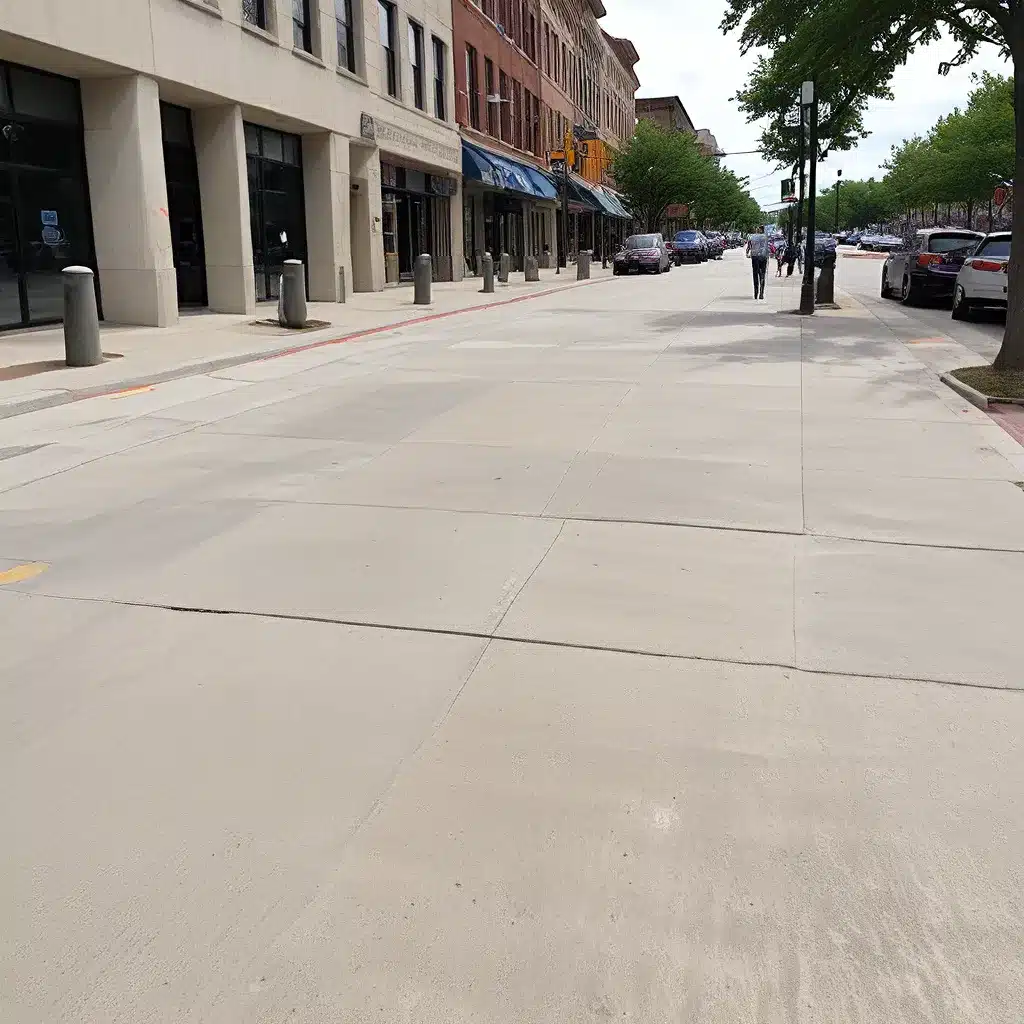
As a bustling Midwest metropolis, Kansas City is constantly evolving to meet the needs of its thriving community. At the heart of this progress lies the importance of concrete, a versatile material that serves as the backbone of the city’s infrastructure. From sidewalks and parking lots to bridges and roadways, concrete plays a crucial role in ensuring the safety and accessibility of Kansas City’s pedestrian areas.
The Importance of Slip-Resistant Concrete
One of the primary concerns when it comes to concrete surfaces in public spaces is maintaining slip resistance. Slippery conditions, whether caused by rain, snow, or general wear and tear, can lead to serious accidents and injuries for pedestrians. This is particularly crucial in areas with high foot traffic, such as downtown Kansas City, where residents and visitors rely on safe and reliable walkways to navigate the city.
Concrete has long been recognized as the preferred surface material for sidewalks, as it offers the longest service life and requires minimal maintenance. However, ensuring a high level of slip resistance is essential to minimizing the risk of falls and collisions.
Enhancing Slip Resistance Through Surface Texturing
One of the most effective ways to enhance the slip resistance of concrete surfaces is through surface texturing. This process involves creating a rougher, more abrasive finish on the concrete, which increases its frictional qualities and provides better traction for pedestrians.
There are several techniques used to achieve this enhanced surface texture, including:
-
Burlap Dragging: This method involves dragging burlaps behind the slip-form machine before straight-edging the surface and attaching more layers of burlap to the curing and texturing machines. This creates a more finished pavement texture with improved slip resistance.
-
Fine Aggregate Mixture: Incorporating a fine aggregate with 25% siliceous particle content can help the concrete pavement withstand the wearing effects of constant traffic, maintaining its skid-resistant properties over time.
-
Reduced Cement-Water Ratio: By reducing the cement-water ratio and increasing the cement factor, the concrete mixture becomes more water-resistant, further enhancing its skid resistance.
These techniques not only improve the safety of pedestrian areas but also contribute to the long-term durability and performance of the concrete surfaces.
Designing for Pedestrian Safety
When it comes to concrete installations in Kansas City, safety is paramount. Beyond surface texturing, there are several design considerations that can further enhance the safety and accessibility of pedestrian areas.
Sidewalk Design
Concrete is the preferred material for sidewalks, as it offers the longest service life and requires minimal maintenance. When designing sidewalks, it’s important to consider factors such as:
-
Thickness: Sidewalk thickness is crucial to prevent premature failure. In areas with a winter freeze, the recommended minimum thickness is 6 inches, while warmer climates may allow for thinner pavements, typically around 3.5 inches.
-
Width: The ideal sidewalk width can vary depending on the area’s needs, but a generous lane width of 12 feet is often recommended to accommodate both pedestrians and bicyclists, reducing the risk of collisions.
-
Accessibility: To ensure the sidewalk is universally friendly, consider lowering the curbs and creating longer slope transitions to eliminate the need for handicap ramps at intersections.
Parking Lot Design
Parking lots can be particularly hazardous areas for pedestrians, as they often involve the shared use of space between vehicles and foot traffic. To improve safety in these areas, consider the following design strategies:
-
Dedicated Pedestrian Walkways: Constructing concrete sidewalks between the noses of vehicles can keep pedestrians safely separated from the traffic area, allowing them to walk directly from their cars to their destinations.
-
Raised Crosswalks: Elevating the pedestrian crosswalks within the parking lot can slow down traffic and make it easier for drivers to spot and yield to pedestrians.
-
Lighting and Visibility: Ensuring adequate lighting and clear sightlines throughout the parking lot can help drivers and pedestrians alike navigate the space safely.
By incorporating these design elements, Kansas City can create concrete-based infrastructure that prioritizes the safety and accessibility of all its residents and visitors.
Maintenance and Longevity
While the initial installation of high-quality concrete is crucial, ongoing maintenance is equally important to ensure the long-term performance and safety of these surfaces. Regular inspections, timely repairs, and the application of protective sealants can all contribute to the durability and slip resistance of concrete pavements.
Partnering with a reputable concrete contractor in Kansas City, such as KE Flatwork LLC, can help property owners and managers develop a comprehensive maintenance plan to keep their concrete surfaces in optimal condition.
Conclusion
As Kansas City continues to evolve, the importance of slip-resistant concrete in pedestrian areas cannot be overstated. By incorporating surface texturing techniques, thoughtful design strategies, and proactive maintenance, the city can create a safer, more accessible environment for residents and visitors alike.
By prioritizing concrete’s slip resistance and long-term performance, Kansas City can enhance the overall quality of life for its community, promoting walkability, accessibility, and enhanced safety on its streets, sidewalks, and parking lots. This commitment to concrete excellence is a testament to the city’s dedication to creating a thriving, livable urban landscape for all.

